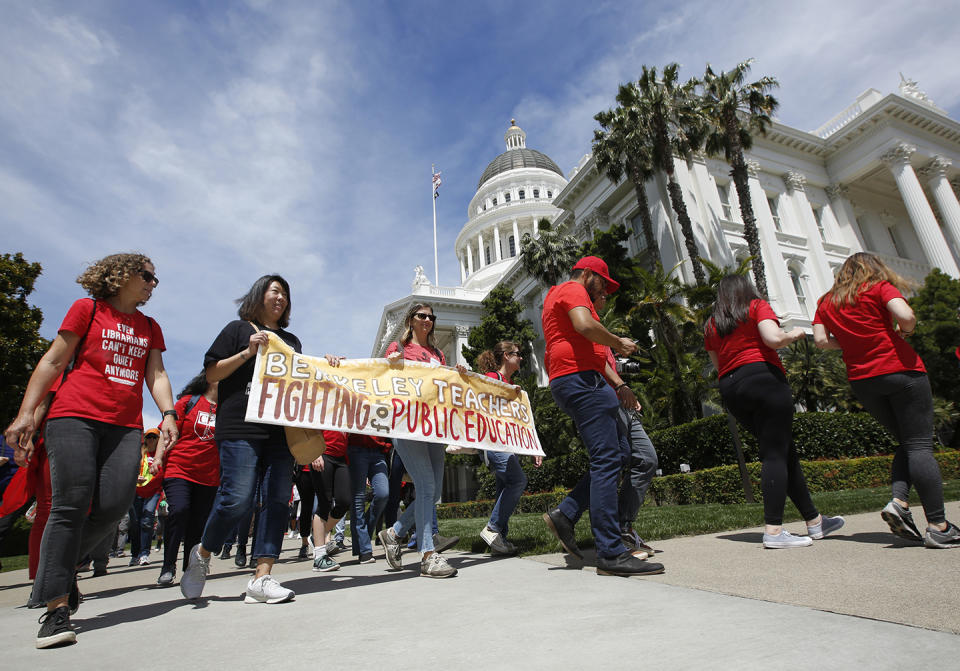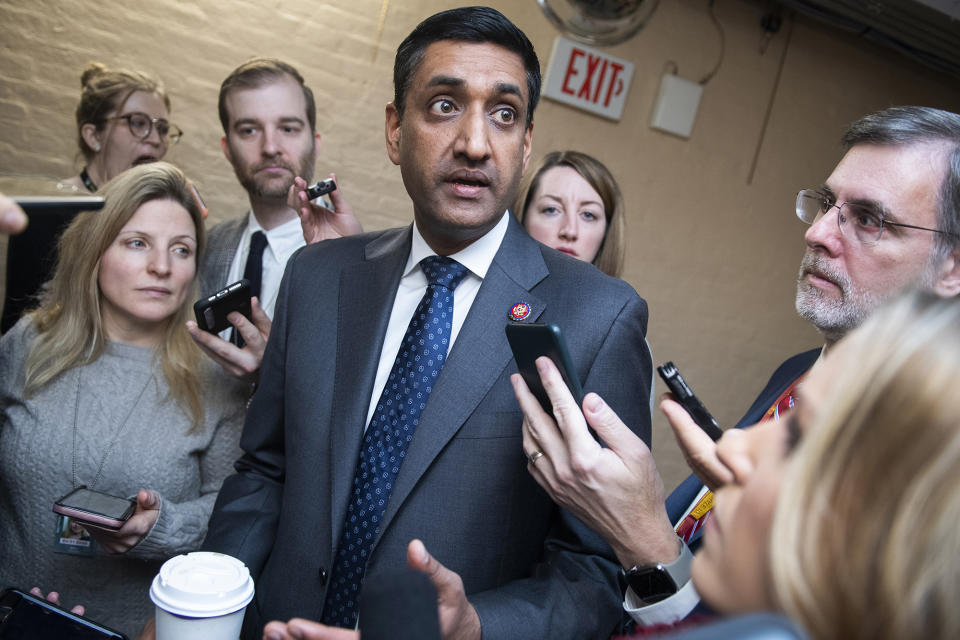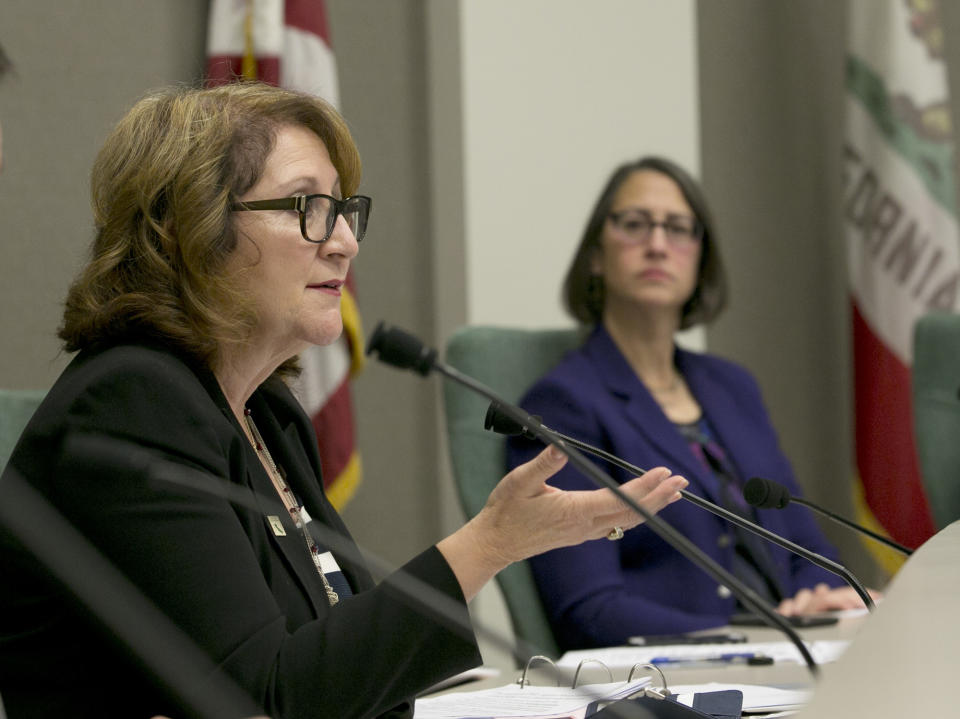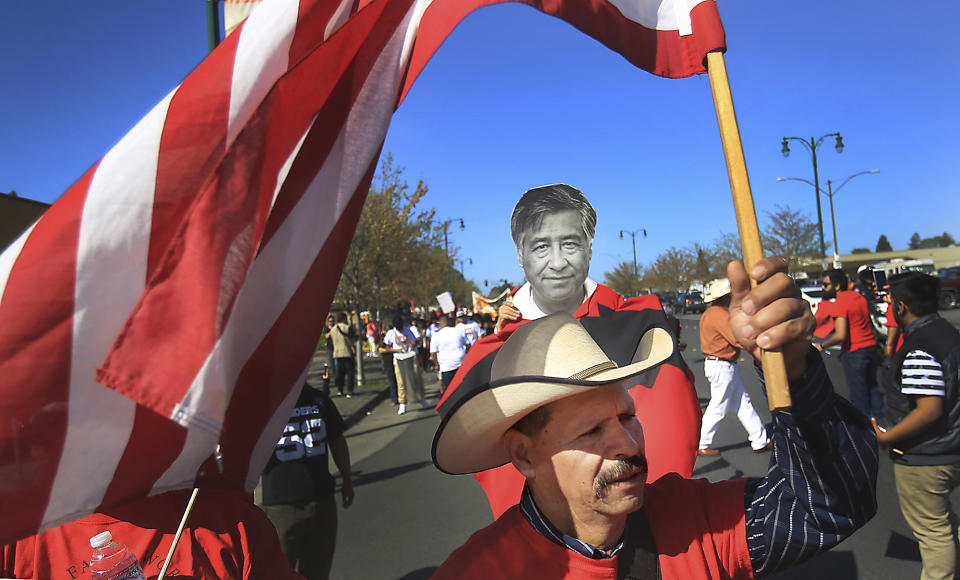The liberal-moderate rift among Democrats has blown open in California
In an earlier era of California politics, Mike Eng would have been a safe bet to win a solidly blue state Senate seat.
A dedicated liberal, Eng enjoyed the name recognition of having served in the state Assembly. He drew support from Assembly Speaker Anthony Rendon, a former protégé who rose to become one of the state’s most powerful figures. Eng had the state’s formidable organized labor movement in his corner. Democratic voters outnumbered Republicans three to one in the Los Angeles district, making a Democratic win a foregone conclusion.
But in modern California politics, the critical fault line isn’t between Democrats and Republicans. It’s between Democrats, thanks to an election system that allows two Democrats to advance out of primaries and collide in the general election. Eng learned this lesson the hard way.
A potent panoply of well-funded interest groups that included the oil industry, charter schools, agriculture, utilities and health care interests spent more than $3 million to buoy a rival Baldwin Park City Councilwoman Susan Rubio. Groups funded by organized labor and consumer attorneys countered with more than $1 million to aid Eng, replicating a clash that has played out in Democrat-on-Democrat races up and down California.
In the end, Rubio prevailed by nearly 5 points.

There is no other state where Democrats wield the absolute power the party enjoys in California. Democrats occupy every statewide office and command two-thirds majorities in both houses. Former GOP strongholds like Orange County have shaded blue. Republicans don’t just lag behind Democrats — there are also fewer registered Republicans than no-party-preference voters.
Before 2011, when the state replaced party primaries with a general primary after which the top two vote-getters square off in the general election, establishment-backed Democrats running in safe seats could often sail to assured victories; now, they often find themselves fighting for their political lives against a rival from their own party.
The liberal-versus-moderate dynamic in California presaged not only the rift that blew open in this year’s presidential primaries, it established its parameters: between unions and environmental activists; between single-payer advocates and Democrats working to expand coverage within the health care system; between educational reformers and teachers unions; between law enforcement and those who regard the legal system as hopelessly biased against communities of color.

California’s experience with top-two voting, rather than partisan primaries, also offers a lesson for other states that are dominated by a single party — like Democrats in Massachusetts or Republicans in Mississippi. In safe seats that would have allowed an earlier generation of Democrats to comfortably coast to victory, California now regularly sees battles between Democrats who differ on issues that otherwise would split along party lines.
Traditionally conservative interests like the oil industry and charter schools increasingly court friendly Democrats — often by contributing money to a constellation of innocuously named political action committees that then spend millions on advertising: In districts where a Democratic win looks inevitable, the thinking goes, better to boost the Democrat who’s likely to vote with you than a Republican who is likely to lose.
David Townsend, a Sacramento political consultant, said he used to have to work to convince business-oriented groups on the wisdom of getting behind Democrats. Now that tactic has become so ingrained that Townsend said he has “a waiting list” of interested players hoping to invest in moderate Democrats.
“Year in and year out the business community, the health care community, the insurance community can look at all the scorecards and see where mods have been on their issues and on trying to tamp down too much regulation,” Townsend said. “We don’t have to do the sell anymore. Everyone totally gets how important the mods are.”
Top-two voting does not lack for critics in California. Speaker Nancy Pelosi and House Minority Leader Kevin McCarthy found rare common ground in mourning the demise of party primaries. Detractors say the general primary empowers interest groups and deprives voters of clear ideological choices.

But its fans include Rep. Ro Khanna, an ascendant progressive star who won his seat by ousting Democratic Rep. Mike Honda in 2016. Khanna said the general primary is “less about ideology” than responsiveness to voters. The new system has “opened up a space for newcomers,” Khanna said — a development that should appeal to voters across the country.
“If you look at the totality of California’s reforms — term limits for assembly members and state senators, independent redistricting and a top-two system — it has led to new voices emerging, more women, more people of color, more independent thinking,” Khanna said. “And my view is that kind of reform is needed across our political spectrum to shake things up, to get rid of this incumbency and status quo that so many Americans reject.”
In the new political world of California, progressives tend to define themselves by their ideals — a "Green New Deal,” single-payer health care, policing reforms for victims of racial discrimination — while moderates practice a more complicated equation of balancing goals and practical effects. There’s no formal moderate Democrat designation. The bloc tends to track with California’s geography, drawing its members from the inland, agricultural and oil-producing districts that can feel like different states than San Francisco or Los Angeles.
“In a one-party state, it’s always important to have balance and deliberation and to ensure all parts of our state are being heard and recognized. I come from the Central Valley and we oftentimes struggle to have our voice heard up here,” said Assemblyman Joaquin Arambula (D-Fresno), who leads the informal moderate caucus. “I believe it’s nice to have aspirational goals, things like getting to 100 percent clean energy — I then wonder how we’re going to fund that and to pay for it.”
Unlike progressives, moderate Democrats often differ with each other: Some are more likely to side with business over labor or vice versa. Many tend to vote with their more progressive counterparts on social issues like abortion or LGBTQ rights while acting more cautiously on economic or law-and-order issues.
“Moderates are like Christians,” Townsend said. “They all have a similar faith, but they often practice it in different ways.”
The rise of the California moderate has not so much redefined the Democratic Party as exposed its fissures:
Unions vs. business
It’s hard to identify a high-level California policy fight that doesn’t prominently feature organized labor, the bedrock of Democratic power in the state and the driving force behind its most far-reaching bills.
The most fiercely contested of those clashes — those that most clearly illuminate the daylight between centrist and liberal Democrats — are often sweeping proposals that would regulate businesses. They tend to appear on the California Chamber of Commerce’s list of “job killer” bills, the pressure points around which business groups rally sympathetic Democrats.
Last year, a measure allowing striking workers to collect unemployment benefits failed to advance beyond the state Senate with some moderate Democratic senators voting no or holding off. Fights over how much family or medical leave employers must offer their workers recur annually, as does organized labor’s long quest to prevent businesses from resolving labor disputes through mandatory arbitration. Business opposition helped sink a labor-priority measure requiring businesses to schedule more predictable shifts for their workers.
New taxes are anathema to various business interests, as are measures that would lower the bar for cities and counties to enact levies of their own. Proposals to do either often falter for lack of Democratic support. A proposed oil severance tax has failed year after year. The 2020 ballot will likely see a teachers-union-supported initiative to alter Proposition 13, California’s cap on property taxes, to lift limits on commercial property taxes. Teachers unions are spending heavily to advance the measure, framing it as a school funding mechanism; business interests have vowed to spend whatever it takes to defeat them.
While Democrats have the legislative supermajorities to enact a compromise measure, the odds of such a negotiation are vanishingly small. Proposition 13 may be reviled by progressives but remains sacrosanct to business interests. Vulnerable Democrats have little incentive to take votes that could cost them at election time.
“I don’t see an incentive for our lawmakers to go up on a revenue enhancement if it’s on the ballot anyways,” Rendon, the Assembly speaker, told POLITICO before the launch of this legislative session.
Unions vs. tech firms
As major tech companies attract greater scrutiny across the country, Silicon Valley has increasingly come into labor’s crosshairs. Major California-based tech companies have bolstered their lobbying presence in Sacramento in recent years, and they’re often fighting labor-backed measures.
That dynamic was never more evident than in 2019, when the California Labor Federation pushed a bill to compel companies like Uber and Postmates to treat their drivers as employees with full benefits; the firms were unable to stymie the bill, but now are spending tens of millions of dollars to overturn it via ballot initiative.
While Democrats ultimately closed ranks behind the measure rather than defy labor, their concerns about the potential fallout bubbled up during debate. At one point, a young, tech-aligned Democrat representing Silicon Valley rose on the Assembly floor to caution his colleagues against the “demonization of an industry that is California-born.”
“The conversation on the inside and outside” about the tech industry, explained Assemblyman Evan Low (D-Campbell), “has been, ‘We don’t want to touch it, it’s too much of a political nightmare.’”
Anti-fossil fuel activists vs. energy advocates
Despite California’s reputation as a paragon of environmental progress, the oil and gas industry remains an economic pillar in certain districts. Energy flows from wells in the kind of rural, inland areas where moderate Democrats’ power base lies. Refineries up and down the state supply well-paying union jobs; Chevron is headquartered in the San Francisco Bay Area.
That economic stature translates into serious political clout. The Western States Petroleum Association regularly tops the list of Sacramento’s top lobbying spenders, and oil companies are major funders of PACs that shower chosen Democrats with millions of dollars each cycle.
A vivid illustration of the industry’s political clout came in 2015, when then-Gov. Jerry Brown and allies sought to require that California motorists cut the amount of petroleum they use in half. The energy industry mobilized, targeting advertisements at the constituents of centrist Democrats in less-than-safe seats, and derailed the petroleum requirement.

In a demonstration of how Democrat vs. Democrat politics works both ways, environmentalists and labor then teamed up to defeat a pro-industry Democrat, Assemblywoman Cheryl Brown, whom opponents dubbed “Chevron Cheryl.”
“Oil donated to Cheryl Brown before — she voted for more fracking and blocked clean energy standards,” an attack ad intoned over images of spewing smokestacks. “The Inland Empire has some of the dirtiest air in the country, but that won’t stop Chevron Cheryl.”
Democratic challenger Eloise Gomez-Reyes defeated Brown in 2016 — and, in 2018, helped lead the charge for a bill that would compel California to eventually generate 100 percent of its electricity from renewable sources.
Agriculture vs. environmentalists and labor
On the other side of mountains cradling the state’s coastal cities is the extraordinarily fertile Central Valley. Peruse any list of crops grown in America, and it’s likely California leads in total output.
Some Central Valley communities remain solidly Republican — their U.S. House representatives include Minority Leader Kevin McCarthy and Rep. Devin Nunes, two of President Donald Trump’s most ardent supporters. But other areas are home to farm-friendly Democrats who uphold a long political legacy of working with prominent industry players like growers and water districts.
Those groups leaned on Democrats to block or dilute measures that would have enhanced labor standards for farm workers and more sharply regulated the use of water — critical economic issues in the Central Valley.
In 2016, the United Farm Workers Union — the storied outfit founded by Cesar Chavez — finally prevailed in its multiyear fight to secure overtime pay for farm workers. While many legislators from agricultural districts warned the bill would devastate small farms, some vulnerable Democrats voted for it.

One Bakersfield Democrat who defied agriculture groups to vote for the overtime bill, Assemblyman Rudy Salas, soon faced a barrage of negative ads funded by the powerful Western Growers Association. But he survived thanks in part to a counteroffensive that showed his cross-cutting allegiances. That included help from the oil industry, reflecting Salas’ business-friendly record — he opposed a gas tax prioritized by former Gov. Brown and legislative leaders — and also aid from the United Farm Workers Union.
Water is a perennial source of conflict in California, and it’s one of the areas where Democrats from farm-heavy districts tend to be closer to Republicans than to their more liberal fellow partisans. The Republican complaint that Democrats favor “fish over farms” — that is, environmental safeguards over more water for crops — resonates with some Democrats.
In the past, agricultural Democrats joined with farmers and water purveyors to work against a measure that sought to impose tighter controls on groundwater; what environmentalists saw as preserving a finite resource, agriculture interests saw an effort by Sacramento to yank a lifeline from farms struggling with a crippling drought.
Last year, pro-agricultural Democrats defied legislative leaders to oppose a so-called Trump insurance bill that would have locked in Obama-era environmental standards. The measure could have upset painstakingly crafted water agreements. Multiple Democrats from agricultural districts spoke or voted against the bill. The measure passed but Gov. Gavin Newsom vetoed it, later telling reporters it was a “solution in search of a problem” that could have blown up water pacts.
“This would have put that entire [water negotiation] process at peril, and I was not willing to do that,” Newsom said.
Education reformers vs. teachers unions
Survey Sacramento insiders on the most powerful player in the California Capitol, and the California Teachers Association would likely sit at or near the top of the list. On issues like teacher employment, education funding and charter school operations, the CTA tends to dictate the agenda. Its positions often predict the outcomes.
That doesn’t mean there’s no dissent. Organizations that promote charter schools and seek to reform teacher tenure rules have spent heavily to combat union clout, bolstered by millions of dollars from a network of affluent, reform-minded Californians.
The number of charter schools in California rose sharply after a 2010 law empowered a majority of parents to trigger changes to local public schools that can include converting them to charters.
During the 2018 California governor’s race, charter-school advocates deployed nearly $23 million to try to vault their chosen Democrat, former Los Angeles Mayor Antonio Villaraigosa, into a same-party runoff with then-frontrunner Newsom. A fellow education reformer, former New York Mayor Mike Bloomberg, gave millions to the pro-Villaraigosa effort.
The gambit failed. Villaraigosa finished third in the nonpartisan primary and Newsom cruised to an easy victory in the general election over Republican businessman John Cox.
Suddenly, charter school advocates had to contend with emboldened union foes and a progressive governor. A flurry of union-backed bills to limit the number of charter schools or make it harder to convert a regular public school into a charter school had the reformers playing defense.
When the Assembly voted on a bill to overhaul the approval process for charter schools, nearly 20 reform-minded Democrats either voted no or withheld their votes. Some of those Democrats had bested other Democrats in crowded primaries after education reformers spent money on their behalf. One of them delivered a floor speech bemoaning efforts to “politicize education” and “pit parents against each other” — an address that the California Charter Schools Association later shared online under the hashtag “KidsNotPolitics.”
Newsom eventually negotiated a compromise measure that prevailed with support from both sides.
Now, in an election year, the charter association issued a slew of endorsements and warned that “non-profit charter public schools are under attack in Sacramento” from “special interests” who “want to protect their privileges at the expense of our students and families.”
Doctors vs. lawyers, nurses and big soda
As an enormous and growing sector of the economy with billions of dollars at stake, health care is ripe for political conflict. And the California Medical Association, which represents doctors, is in the middle of most of them.
While a cluster of California cities have instituted soda taxes, proposals to tax or label sugar-sweetened beverages — pushed year after year by the CMA and public health groups — perish with predictable regularity. Decisive resistance often comes from Democrats who warn those policies would harm unionized bottling plants or burden the poorest Californians. The American Beverage Association and member companies like Coca-Cola regularly spread campaign contributions among both Republicans and centrist Democrats.
Then there are clashes among various health care interest groups. The California Nurses Association is one of the most aggressive and liberal players in California politics, advocating single-payer health care legislation.
That has pitted nurses against other players who claim that converting to a single-payer system would be too costly and unworkable. When a single-payer bill hit the Senate floor in 2017, it had to overcome the opposition of both insurers and the CMA. The single-payer legislation passed narrowly with several Democrats withholding their support and was soon halted by Assembly leadership, setting off an ugly wave of recriminations and Democratic infighting.
The following year, with those wounds still smarting, the CMA launched a new anti-single-payer group with insurers and hospitals.
Beyond the agenda-grabbing issue of single-payer health care, the CMA regularly engaged in turf wars with other interest groups. Groups representing doctors and nurses clashed over “scope of practice” rules — essentially, how much leeway nondoctors have to perform some procedures. But doctors aren’t just squaring off with nurses.
Earlier this year, a Senate committee halted a bill, prioritized by LGBTQ groups but contested by doctors, to prohibit early surgical interventions on intersex children. Days before the hearing, the CMA channeled $50,000 to a new committee buoying one of the most centrist Senate Democrats, Steve Glazer, as he faced a union-backed challenger. Glazer chairs the decisive committee.
Doctors also have a longtime nemesis in trial lawyers, another reliable Democrat-backing interest group in California. Tensions between doctors and lawyers most often manifest in battles over California’s cap on medical malpractice payouts, which lawyer-aligned groups have long fought to raise.
With the latest iteration of that clash likely going on the ballot in 2020, the CMA recently uncorked a $5 million initiative to beat it back. The fact that the recurring fight tends to play out via ballot initiative, rather than legislation, speaks to the CMA’s power to quash any effort originating in the statehouse.
Law enforcement vs. criminal justice reformers
Not long ago, California’s stringent sentencing laws embodied the tough-on-crime policies prevailing across America. Political dynamics have shifted dramatically since then, with California lawmakers and voters approving a raft of bills and ballot initiatives to ease sentencing, legalize recreational marijuana use, open law enforcement records and restrict when police officers can use lethal force.
Even as that sea change has taken place, law enforcement groups have remained influential in Sacramento. Many lawmakers, particularly those with narrower roads to reelection, are wary of antagonizing local police chiefs, sheriffs and district attorneys.
Groups representing rank-and-file police officers, prison corrections officers and sheriff’s deputies regularly give money to Democratic lawmakers. In some cases, the law enforcement tie is explicit: Democratic Assemblyman Jim Cooper, a former sheriff’s deputy and a stalwart law enforcement backer, was facing a challenge this cycle from a well-funded Democratic opponent. Earlier this year a new pro-Cooper PAC emerged named “Keep a Cop in the Capitol.”
In 2018, law enforcement officers successfully quashed legislation that would have limited their ability to use lethal force. When the bill returned in 2019, law enforcement groups sponsored a diluted alternative promoted by a moderate Democrat. They funded advertisements warning that the version sought by reformers “would turn cops into criminals”; fliers distributed in Sacramento summarized the proposal’s effect as “another dead cop.”
Law enforcement advocates ultimately endorsed a more reform-oriented compromise measure.
The compromise was followed by outright losses for law-enforcement interests in sentencing and accountability measures. But the margin of those votes demonstrated how Democrats are far from monolithic on matters of law and order. A 2018 bill that prohibited prosecutors from trying minors in adult court for serious crimes like murder squeaked off the Assembly floor with the bare minimum of votes. So too did a 2019 measure barring certain sentencing enhancements for career criminals.
On the latter, resistant Democrats warned of the consequences: “These are the dangerous criminals that we should be locking up and keeping out of the public for public safety,” declared one Assembly member who had lost and then regained his battleground seat. “Let’s not lose our credibility, Democrats, by pushing for all these criminal justice reform bills.”
More battles on the horizon
From San Diego to Sacramento, California’s primary in March offered examples of money-saturated battles between Democrats. Oil companies, real estate agents, education reformers and other traditionally right-leaning interests muscled up with contributions to buoy their chosen Democrats, often counteracted by liberal activists and, in some cases, organized labor.
In many cases, Democrats accused their fellow party members of unfair play. In the race to fill the safely Democratic U.S. House seat in San Diego held by retiring Rep. Susan Davis, one Democrat accused her Democratic opponent of trying to push a Republican into the runoff with an ad whose lines of attack — highlighting the Republican’s record on guns and Trump — could read like positive qualifications to conservative voters. A top Democratic election strategist denounced the real estate industry’s successful effort to boost a baggage-laden Democrat into the general election as “the sleaziest tactic I’ve ever seen” and “a crime against humanity.”
But the best illustration of the divisions among Democrats may have once again, like the Los Angeles race won by Susan Rubio against Mike Eng in 2018, involved a member of the Rubio family. When Assemblyman Ian Calderon (D-Whittier) resigned his safe seat in the south San Gabriel Valley — near Richard Nixon’s childhood home in Whittier — a flood of Democratic candidates joined the nonpartisan primary — among them Calderon’s stepmother, Lisa Calderon, and Susan Rubio’s younger sister Sylvia Rubio.
Business interests once again lined up behind Rubio’s sister. Labor went all-in for Lisa Calderon, energized by the revelation that Rubio had once been a registered Republican. By Election Day, both sides had collectively plowed more than $2.7 million into outside spending for a single Assembly seat — a staggering investment by interest groups hoping to elect a Democrat in their image.
As the finals votes trickled in, Calderon led Rubio by about 2,500 votes. A token Republican sat in first, thanks to the fractured Democratic field, making it all but certain that come next year, organized labor will have the Democrat they want.

